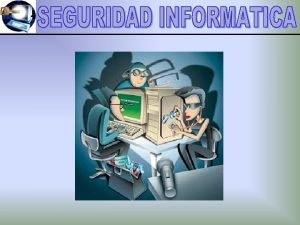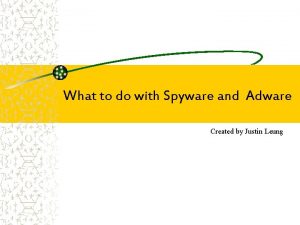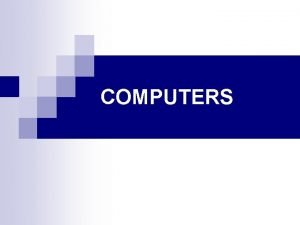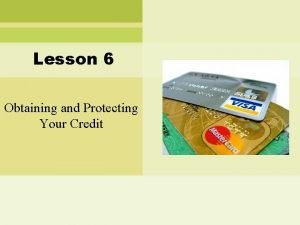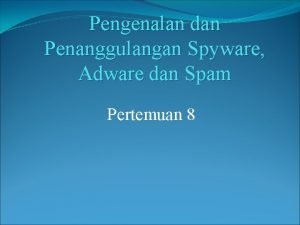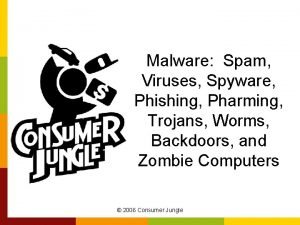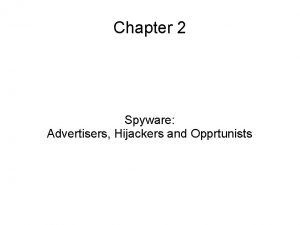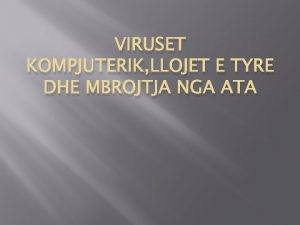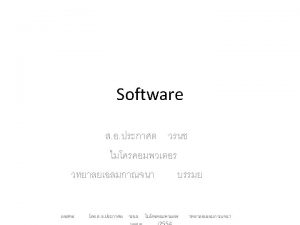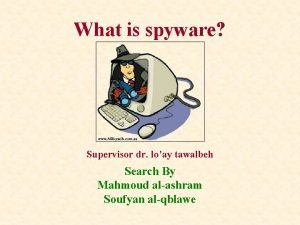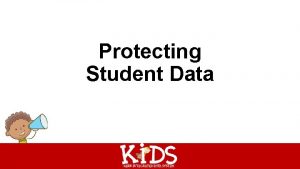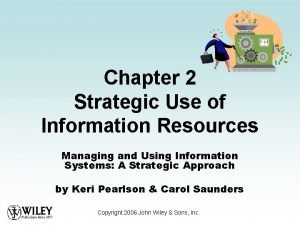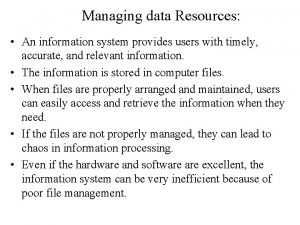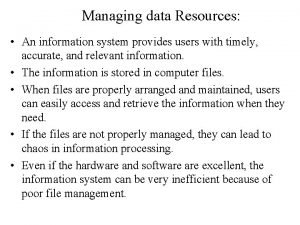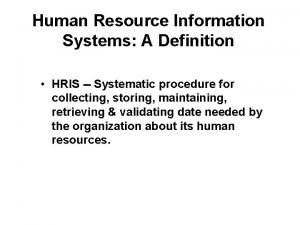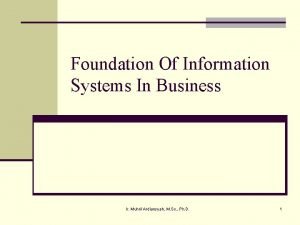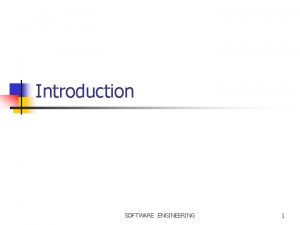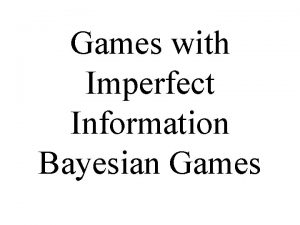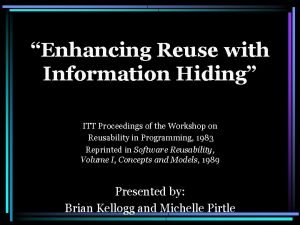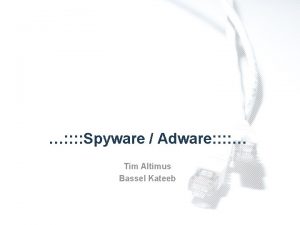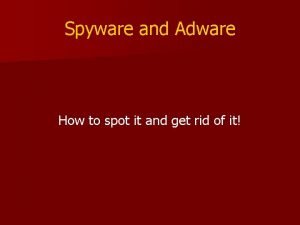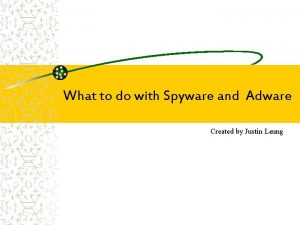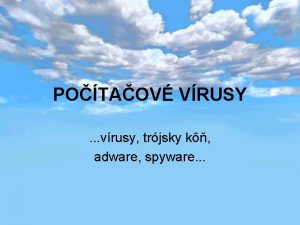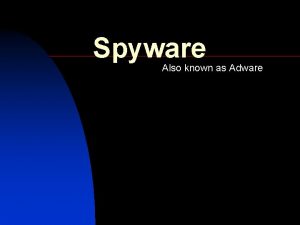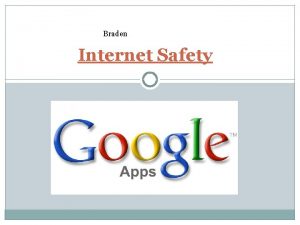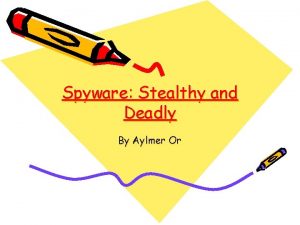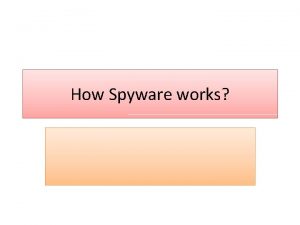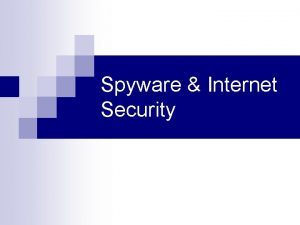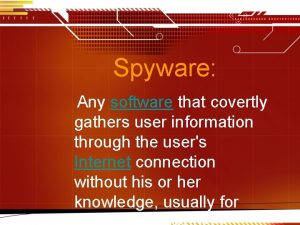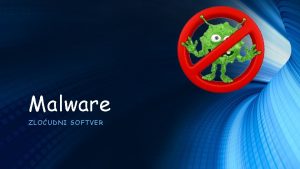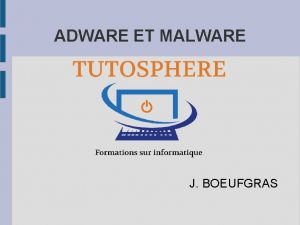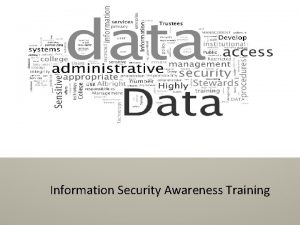PROTECTING INFORMATION RESOURCES Spyware and Adware Spyware Software












































- Slides: 44

PROTECTING INFORMATION RESOURCES

Spyware and Adware • Spyware – Software that secretly gathers information about users while they browse the Web – Can be used maliciously • Install antivirus or antispyware software • Adware – Form of spyware – Collects information about the user to display advertisements in the Web browser

Phishing • Phishing – Sending fraudulent e-mails that seem to come from legitimate sources • Direct e-mail recipients to false Web sites – To capture private information

Keystroke Loggers • Keystroke loggers – Monitor and record keystrokes – Can be software or hardware devices – Sometimes used by companies to track employees’ use of e-mail and the Internet – Can be used for malicious purposes • Some antivirus and antispyware programs protect against software keystroke loggers

Sniffing and Spoofing • Sniffing – Capturing and recording network traffic – Often used by hackers to intercept information • Spoofing – Attempt to gain access to a network by posing as an authorized user to find sensitive information

Computer Crime and Fraud • Computer fraud – Unauthorized use of computer data for personal gain • Social networking sites – Used for committing computer crime • Examples – Denial-of-service attacks – Identity theft – Software piracy – Distributing child pornography – E-mail spamming

Computer Crime and Fraud (cont’d. ) – Writing or spreading viruses, worms, Trojan programs, and other malicious code – Stealing files – Changing computer records – Virus hoaxes – Sabotage • Company insiders commit most computer crimes

Computer and Network Security: Basic Safeguards • Critical for most organizations – Especially in recent years, with hackers becoming more numerous and adept at stealing and altering private information • Hackers use a variety of tools to break into computers and networks – Sniffers, password crackers, and rootkits (a stealthy type of software, often malicious, designed to hide the existence of certain processes or programs from normal methods of detection and enable continued privileged access to a computer) – Journals Phrack and 2600: The Hacker Quarterly

Computer and Network Security: Basic Safeguards (cont’d. ) • Comprehensive security system – Protects an organization’s resources – Including information and computer and network equipment, e-mails, invoices transferred via electronic data interchange (EDI), new product designs, marketing campaigns, and financial statements • Threats: – Include sharing passwords with co-workers, leaving a computer unattended while logged on to the network, or even spilling coffee on a keyboard

Computer and Network Security: Basic Safeguards (cont’d. ) • Comprehensive security system – Includes hardware, software, procedures, and personnel that collectively protect information resources • Confidentiality – System must not allow disclosing information to anyone who isn’t authorized to access it – Secure government agencies – Businesses – E-commerce

Computer and Network Security: Basic Safeguards (cont’d. ) • Integrity – Ensures the accuracy of information resources in an organization – Financial transactions • Availability – Ensures that computers and networks are operating – Authorized users can access the information they need

Computer and Network Security: Basic Safeguards (cont’d. ) • Three levels of security – Level 1: front-end servers • Available to both internal and external users. E-mail and Web servers • Protect against unauthorized access – Level 2: back-end systems • Users work stations and internal DB servers must be protected – Level 3: corporate network • Protect against intrusion, Do. S attacks and unauthorized access • Fault-tolerant systems – – Combination of hardware and software for improving reliability Uninterruptible power supply (UPS) Redundant array of independent disks (RAID) Mirror disks • Uses 2 disks containing the same data so that if one fails the other is available • Less expensive than RAID

Security Threats: An Overview • Some threats can be controlled completely or partially, but some can’t be controlled • Categories – Unintentional – Intentional

Intentional Threats • • • Viruses Worms Trojan programs Logic bombs Backdoors Blended threats (e. g. , worm launched by Trojan) Rootkits Denial-of-service attacks Social engineering

Viruses • Type of malware • Estimating the dollar amount of damage viruses cause can be difficult • Usually given names – I Love You, Michelangelo • Virus: Consists of self-propagating program code that’s triggered by a specified time or event

Viruses (cont’d. ) • Seriousness of viruses varies • Transmitted through a network and e-mail attachments – Bulletin or message boards • Virus hoaxes – Can cause as much damage as real viruses • Indications of a computer infected by a virus • Best measure against viruses – Installing and updating antivirus programs

Worms • Travels from computer to computer in a network – Does not usually erase data • Independent programs that can spread themselves without having to be attached to a host program • Replicates into a full-blown version that eats up computing resources • Well-known worms – Code Red, Melissa, and Sasser

Trojan Programs and Logic Bombs • Trojan program – Named after the Trojan horse the Greeks used to enter Troy during the Trojan War – Contains code intended to disrupt a computer, network, or Web site – Usually hidden inside a popular program • Logic bomb – Type of Trojan program used to release a virus, worm, or other destructive code – Triggered at a certain time or by an event

Backdoors and Blended Threats • Backdoor – Programming routine built into a system by its author – Enables the author to bypass security and sneak back into the system later to access programs or files – Users aren’t aware a backdoor has been activated • Blended threat – Combines the characteristics of several malicious codes with vulnerabilities on public/private networks – Goal is not to just start/transmit an attack, but to spread it – Multi-layer security system can guard from threats

Denial-of-Service Attacks • Floods a network or server with service requests – Prevent legitimate users’ access to the system • Target Internet servers • Distributed denial-of-service (DDo. S) attack – Hundreds or thousands of computers work together to bombard a Web site with thousands of requests for information in a short period – Difficult to trace

Social Engineering • Using “people skills” to trick others into revealing private information – Takes advantage of the human element of security systems • Use the private information they’ve gathered to break into servers and networks and steal data • Commonly used social-engineering techniques – “Dumpster diving” and “shoulder surfing” • Choice Point example Choice. Point is in the business of gathering personal data about consumers that it sells to insurance companies, banks, government agencies, and businesses. Buyers of that data use it to determine insurance premiums and interest rates, do pre-employment screening, etc. It turns out that scammers have been posing as small businesses to improperly access data about individuals. The scammers would open accounts with Choice. Point masquerading as small businesses and then improperly use the sensitive personal data for identity fraud. 145, 000 American consumer records at Choice. Point were compromised.

Protecting Against Data Theft and Data Loss • Portable storage media – Theft or loss of media – Stealing company data • (memory sticks, USB drives, CDs etc. ) • Guidelines to protect against these risks

Security Measures and Enforcement: An Overview • • Biometric security measures Nonbiometric security measures Physical security measures Access controls Virtual private networks Data encryption E-commerce transaction security measures Computer Emergency Response Team

Biometric Security Measures • Use a physiological element unique to a person • Biometric devices and measures – Facial recognition – Fingerprints – Hand geometry (compare length of each finger, webbing between fingers, translucence of fingertips) – Iris analysis – Palm prints – Retinal scanning – Signature analysis – Vein analysis (analyze the pattern of veins in wrist and back of hand) – Voice recognition

Examples of Biometric Devices

Nonbiometric Security Measures • Main security measures: – Callback modems – Firewalls – Intrusion detection systems

Callback Modems • Verify whether a user’s access is valid by: – Logging the user off – Calling the user back at a predetermined number • Useful in organizations with many employees who work off-site

Firewalls • Combination of hardware and software • Acts as a filter or barrier between a private network and external computers or networks • Network administrator defines rules for access • Examine data passing into or out of a private network – Decide whether to allow the transmission based on users’ IDs, the transmission’s origin and destination, and the transmission’s contents

Basic Firewall Configuration

Firewalls (cont’d. ) • Possible actions after examining packet – – Reject the incoming packet Send a warning to the network administrator Send a message to the sender that the attempt failed Allow the packet to enter (or leave) the private network • Main types of firewalls – Packet-filtering firewalls – Application-filtering firewalls – Proxy servers • Software that acts as an intermediary between 2 systems (network users and Internet). Protects network against unauthorized access from outside the network • Can also be used as a firewall that scans for malware and viruses • Can also block requests from certain servers

Proxy Server

Intrusion Detection Systems • Protect against both external and internal access • Usually placed in front of a firewall • Prevent against Do. S attacks • Monitor network traffic • “Prevent, detect, and react” approach • Require a lot of processing power and can affect network performance

Physical Security Measures • Primarily control access to computers and networks • Include – Cable shielding – • braided layers around cable to protect it from interference – Corner bolts – Electronic trackers – • connected to computer at outlet. If power cord is disconnected an alarm sounds or a camera records what happened – Identification (ID) badges – Proximity- • release door openers- transmitter in employee badge and will unlock door within a certain radius – Room shielding – • nonconductive material sprayed in computer room which reduces signals which can be transmitted – Steel encasements – • Fit over entire computer and can be locked

Lost and Stolen Laptops • Recommendations: – Install cable locks and use biometric measures – Only store confidential data when necessary – Use passwords – Encrypt data – Install security chips – disable laptop if unauthorized user trys to access it. Some send signal and a GPS alert showing location of laptop

Access Controls • Terminal resource security – Software feature that erases the screen and signs the user off automatically after a specified length of inactivity • Password – Combination of numbers, characters, and symbols that’s entered to allow access to a system – Length and complexity determines its vulnerability to discovery – Guidelines for effective passwords

Virtual Private Networks • Provides a secure “tunnel” through the Internet – For transmitting messages and data via a private network • Remote users have a secure connection to the organization’s network • Low cost • Slow transmission speeds

Data Encryption • Transforms data, called plaintext or cleartext, into a scrambled form called ciphertext • Rules for encryption determine how simple or complex the transformation process should be – Known as the “encryption algorithm” • Protocols – Secure Sockets Layer (SSL) • security on Internet (https) or padlock icon on status bar – Transport Layer Security (TLS) • security over public networks

Using Encryption

Data Encryption (cont’d. ) • Key size – Between 32 and 168 bits • Main types of encryption – Asymmetric also called “public key encryption” • Public key known to everyone • Private key known only to recipient • Message encrypted with public key can only be decrypted with same algorithm used with public key but also needs the private key • Slower, requires a lot of processing power – Symmetric – “secret key”. • Same key used to encrypt and decrypt. • Advanced Encryption Standard uses 56 -bit key. The technique used by U. S Government

E-commerce Transaction Security Measures • Three factors are critical for security: – Authentication – of credit cards – Confirmation- verify orders and receipt of shipments – Nonrepudiation – needed in case there is a dispute. Digital signitures are used • Transaction security – – – Confidentiality - only the sender and recipient can read message Authentication – how can recipient know message came from sender Integrity – data’s content has not been changed Nonrepudiation of origin – sender can’t deny sending data Nonrepudiation of receipt - recipient can’t deny receiving data

Computer Emergency Response Team • Developed by the Defense Advanced Research Projects Agency • Focuses on security breaches and Do. S attacks • Offers guidelines on handling and preventing these incidents • Cyber Incident Response Capability (CIRC) – http: //www. doecirc. energy. gov/aboutus. html

Guidelines for a Comprehensive Security System • Train employees • Guidelines and steps involved – People – Procedures – Equipment and technology

Business Continuity Planning • Outlines procedures for keeping an organization operational • Prepare for disaster • Plan steps for resuming normal operations as soon as possible

Summary • Impact of IT tools on privacy – Use of IT tools to commit computer crimes • Basic safeguards, fault-tolerant systems – Intentional security threats • Biometric, nonbiometric, and physical security measures; access controls, firewalls, intrusion detection systems • Establish comprehensive security system and business continuity plan
 Adware virus informatico
Adware virus informatico Adware sweeper
Adware sweeper Abandonware licencja
Abandonware licencja Wavelink enabler
Wavelink enabler Trojan horses spyware and worms are all forms of
Trojan horses spyware and worms are all forms of Obtaining and protecting your credit
Obtaining and protecting your credit Chapter 9 obtaining and protecting your credit
Chapter 9 obtaining and protecting your credit Chapter 9 obtaining and protecting your credit
Chapter 9 obtaining and protecting your credit Protecting consumers savers and investors examples
Protecting consumers savers and investors examples Transformed and transforming resources
Transformed and transforming resources Difference between fixed and variable resources
Difference between fixed and variable resources Spyware adalah
Spyware adalah Example of spyware
Example of spyware 2spyware
2spyware Si te mbrohemi nga viruset kompjuterike
Si te mbrohemi nga viruset kompjuterike Spyware
Spyware The spyware used in intimate partner violence
The spyware used in intimate partner violence Spyware dr
Spyware dr Anti spyware 101
Anti spyware 101 Chapter 20 civil liberties protecting individual rights
Chapter 20 civil liberties protecting individual rights Reactions of aldehydes and ketones summary
Reactions of aldehydes and ketones summary Ch3li reaction with ketone
Ch3li reaction with ketone Carbamate protecting group
Carbamate protecting group Important john proctor quotes
Important john proctor quotes Protecting student data
Protecting student data Single species approaches to protecting biodiversity
Single species approaches to protecting biodiversity Single species approaches to protecting biodiversity
Single species approaches to protecting biodiversity Chapter 20 civil liberties protecting individual rights
Chapter 20 civil liberties protecting individual rights Chapter 20 civil liberties protecting individual rights
Chapter 20 civil liberties protecting individual rights Renewable resources vs nonrenewable resources
Renewable resources vs nonrenewable resources Strategic use of information resources
Strategic use of information resources Managing information technology resources
Managing information technology resources Data resources in information system
Data resources in information system Managing data resources
Managing data resources Human resource information system definition
Human resource information system definition Strategic use of information resources
Strategic use of information resources Qmanagement
Qmanagement Information resources management
Information resources management Environmental resources in software engineering
Environmental resources in software engineering Chapter 3 skills and applications
Chapter 3 skills and applications Generic software and custom software
Generic software and custom software Difference between student software and industrial software
Difference between student software and industrial software Software metrics example
Software metrics example Imperfect information vs incomplete information
Imperfect information vs incomplete information Information hiding in software engineering
Information hiding in software engineering
